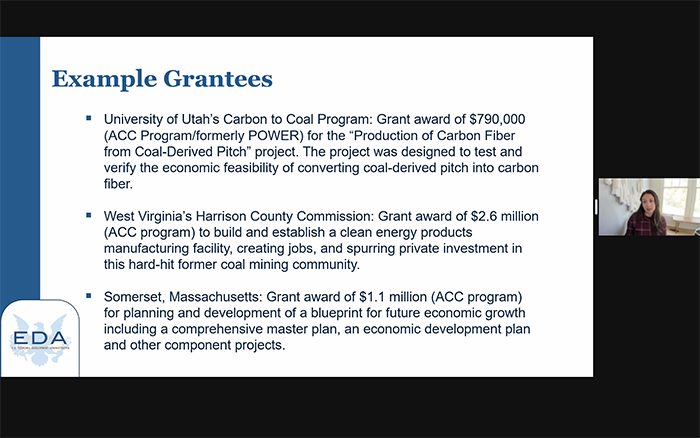Today, the Interagency Working Group (IWG) on Coal and Power Plant Communities and Economic Revitalization and the United States Energy Association (USEA) hosted a half-day workshop that explored the many benefits of repurposing legacy fossil fuel infrastructure, including closed coal mines, coal power plants, and orphaned oil and gas wells.
“Repurposing Fossil Assets” featured local voices and federal agency leaders as they discussed lessons learned from projects aimed at repurposing fossil assets and funding available through the Bipartisan Infrastructure Law (BIL) and ongoing appropriations for these efforts.
“Transforming legacy fossil fuel infrastructure can help communities in countless ways — from environmental remediation and reducing super-polluting methane emissions, to economic development, job creation, community revitalization, and so much more. The funding available for reclamation and repurposing projects, including historic investments from the Bipartisan Infrastructure Law will help build a stronger, healthier and more prosperous future for energy communities,” said IWG Executive Director Brian Anderson, Ph.D.
Attendees heard several real-life examples of successful, in progress or proposed projects to reclaim and transform fossil assets in energy communities. Case studies included recovery of coal mines, abandoned oil wells, and brownfields to create exciting new projects involving nuclear, biomass, solar, wind, data centers, energy storage and more. To highlight a few:
- Alan Larson with Larson Enterprises, a firm with a long history in mining, reclamation and environmental management, discussed a solar farm currently under construction on a reclaimed mine site.
- Stephen Collins with Commercial Development Company, Inc. talked about the Somerset Power Plant in Massachusetts.
- Kemp Gregory and Stefan Streckfus with Renewell Energy highlighted their company’s mission to “convert oil and gas’s largest liability into renewable energy’s greatest asset.”
- Neil Pansey of CMS Enterprises discussed the rationale to convert the TES Filer City Station from coal to biomass with an option to add a carbon capture plant.
At the federal panel discussion portion of the workshop, representatives from the IWG, U.S. Economic Development Administration, U.S. Environmental Protection Agency and U.S. Departments of Energy, the Interior, and Labor examined how funding from the BIL and ongoing appropriations can impact fossil asset transition. The BIL provides $19 billion in funding for fossil asset reclamation and repurposing projects, which is in addition to the existing funding from ongoing appropriations. Some opportunities highlighted during the webinar include:
- U.S. Economic Development Administration
– Assistance to Coal Communities
– Economic Adjustment Assistance Program - U.S. Environmental Protection Agency
– Brownfields Categorical Grants
– Brownfields Projects - U.S. Department of Energy
– Clean Energy Demonstration Program on Current and Former Mine Land
– Funding to Support Orphan Well Plugging - U.S. Department of the Interior
– Abandoned Mine Reclamation Fund
– Orphaned Well Site Plugging, Remediation, and Restoration - U.S. Department of Labor
– Workforce Opportunity for Rural Communities (WORC)
– Apprenticeship Building America (ABA) Grant
“It’s inspiring to hear from companies who are successfully reclaiming abandoned coal mines, power plants and oil wells and putting them to good use in the clean energy economy.” said Anderson. “It’s also exciting to see how the unprecedented levels of federal funding from the Bipartisan Infrastructure Law will create even more opportunities for energy communities in the coming months.”
The workshop also debuted a new interactive website for the public to find information on fossil assets across the country. This website will allow developers to collaborate on securing corporate engagement and program input to advance efforts to repurpose fossil assets.
Three breakout sessions closed out the afternoon, each with a different topic — mines, power plants, or wells and petroleum assets — that offered attendees an opportunity to discuss the topics in more detail with experts and other attendees.
The webinar recording, presentation slides, and final agenda can be found here.
Established by an Executive Order during President Biden’s first week in office, the IWG is pursuing a whole-of-government approach to create good-paying union jobs, spur economic revitalization, remediate environmental degradation and support energy workers in coal, oil and gas, and power plant communities across the country as the U.S. prepares to undergo a historic energy evolution to a carbon emission-free electricity sector by 2035 and economy-wide net-zero emissions by 2050.

 )
or https:// means you’ve safely connected to
the .gov website. Share sensitive information only on official,
secure websites.
)
or https:// means you’ve safely connected to
the .gov website. Share sensitive information only on official,
secure websites.

